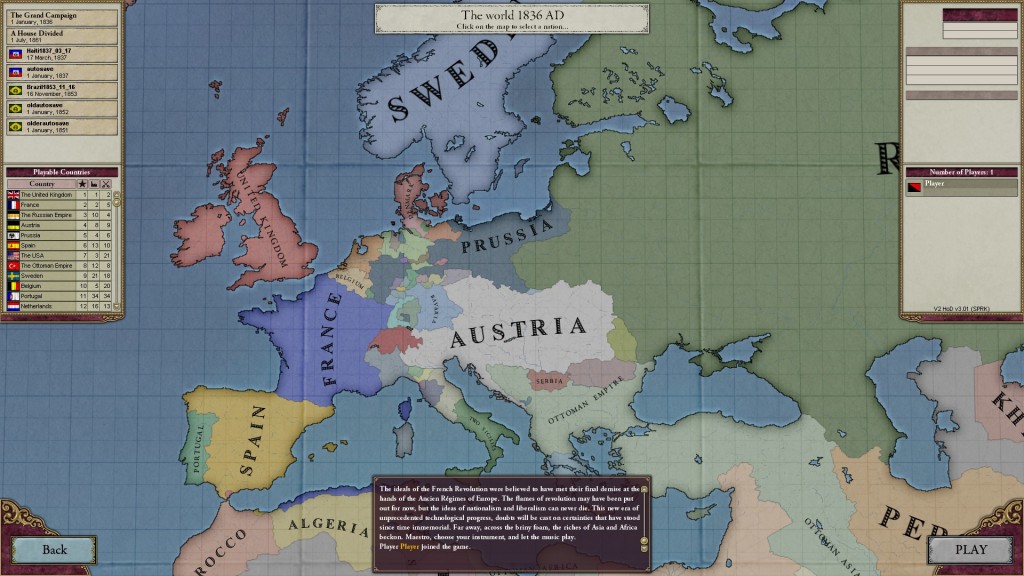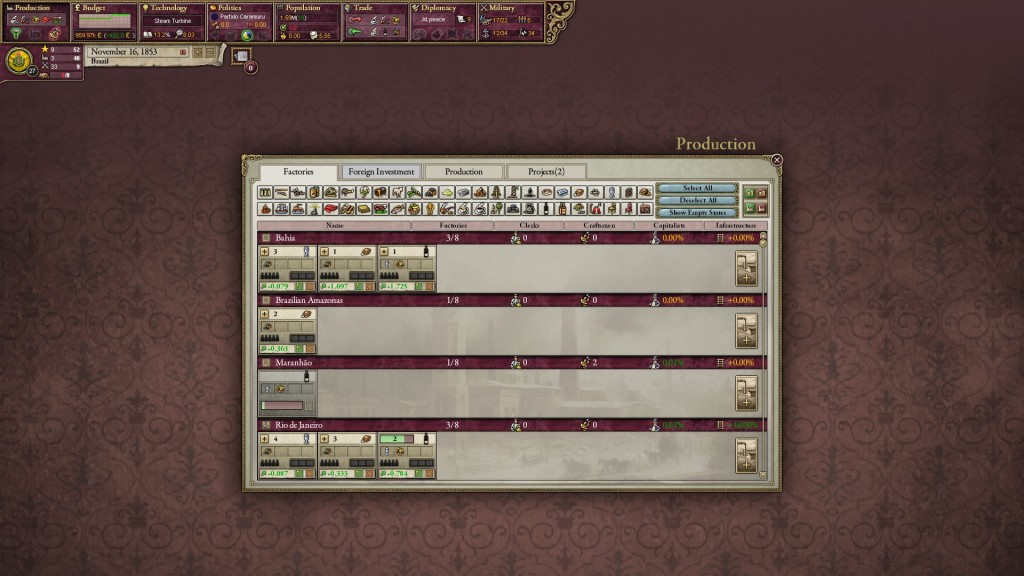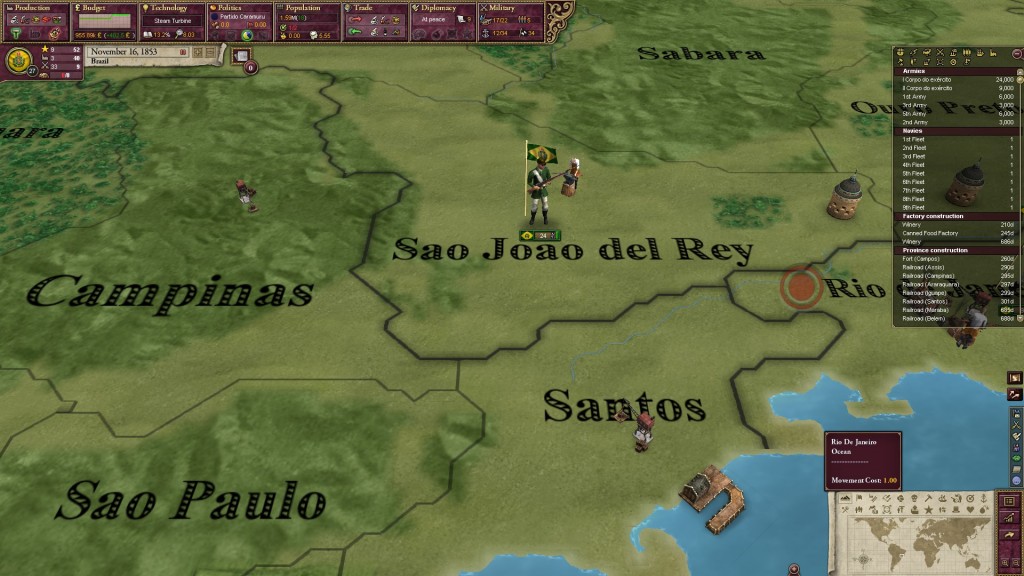
Developer: Paradox Development Studio
Publisher: Paradox Interactive
Platform: PC
Victoria II – Review
Victoria II is a grand strategy game which focuses more on politics and economy than warfare. Developed by Paradox Development Studio as a sequel to their Victoria I game. Let’s see how they did on this second installment, shall we?
Story:
The story is quite straightforward, in Victoria II you choose one of the countries that existed from 1836 until the start of 1936 (a whopping 200 countries!). Afterwards you go through the course of history as that country, moulding its history as you see fit, while going through the industrialization, nationalism and even the American Civil War. All countries start at a historically correct time. For example : If you play as Belgium, you will start in times of war with the Netherlands. And as Japan you will start as an isolated and “uncivilized” country that is unable to build factories at the beginning of your playthrough.
Sound:
I am not a big fan of the sound effects the games uses. Every click you do has a corresponding loud “click” sound. This may sound weird or even illogical, but it feels like the best way to describe it. Other noises, like when selecting an army you hear 2 swords clashing against each other. Whe na news article gets published, you hear the sound of a newspaper being opened. These are way more fitting and do not annoy so easily. The music however is pretty well made and gives a nice extra touch to the game.
All in all the sound track is pretty decent, the music is good and a lot of the noises are fitting, yet that loud click urged me to set effect volume to 0 almost instantly.
Graphics:
Graphic wise the game is superb, it is very detailed in the shape and size of the countries and even their provinces are correct. The smaller things are very well made aswell, you can build railroads in provinces and if 2 neighbouring provinces have both built them, they will get linked on your screen with the railroads as well. All your factories ,forts and even shipyards have their own sprite on your map. All goods and even the different populations have their own detailed sprite.
Gameplay:
Gameplay wise it is practically mandatory to go through the tutorials first, the game has 12 basic, 10 Intermediate and 10 expert tutorials. As its name implies the basic tutorial only explains all the different submenus in the game itself without going in too many details. The game is difficult and it is not your average RTS in which you can jump in and figure out most of the things along the way. There is quite a bit of micro-management involved in playing the markets to earn cash and in handling the population. This is why I highly recommend at least playing the basic and intermediate tutorials before actually starting a normal game. Of course the tutorials might feel a little overwhelming at first, they give you a lot of information at once, which you have to try and process – and don’t forget memorize! – before playing.
Once you get the hang of the basics with the tutorials, it’s time to go play! The game has a multiplayer mode for those who want to play Victoria II with friends via LAN or over the internet, but the main part of the game is in the Single player campaign.
First off you pick a country to play, I was suggested to pick Sweden, Haiti or Brazil in my first game and so I picked Brazil. You start off with a small army, while the game is paused for now. Most of the game can now be controlled by going to the submenus that cover all aspects of your country, these are :
Production: Here you can see all factories in their different provinces and also start construction on new ones. It also has a comprehensive list of the goods being crafted in your nation.
Population: This tab shows your whole population whom you can divide by province or by their craft. It also shows their political views , their nationality, religion and even what they believe to be the big issues in your nation.
Trade: This one, kind of speaks for itself. You decide what goods you buy or sell and in what amounts. You can also let the game do this automatically, which is usually a good idea if you’re just starting out. Most goods will go to your national stockpile, where they can be sold again or used by your factories or people. Every good also specifies how many you need for the government, the population or the factories and how many you have available at the moment in your stockpile.
Budget: Could also have been called taxation, here you decide on how you tax the 3 different groups in population, the poor , middle class and the rich. Contrary to my believes, it is best to tax the poor as much as you can , while keeping the middle class and rich practically tax-free so they can invest in your factories. You can also take loans (and repay them, but who would?!) and decide where the government’s cash gets invested. For example in education, Military matters and Social housing.
Politics: Speaks for itself again, you can see the leading party in your government and also see their takes on various topics like slavery and industrialization. You can also see and choose reforms here.
Diplomacy: Here is a list of all the various other nations with which you can ally, ask for reinforcements, declare war upon and so on. It also has a list of the current ongoing wars around the globe.
Military: Here you can create new armies and assign or create new generals to them. The same for your military fleet and it’s admirals.
Technological advancements: Here you can choose what research you want to do. There are different technology “trees” to choose from, these are kind of self-explanatory so I will just sum them up here. You have Army, Navy, Commerce , Industry and Culture.
The key to this game is balancing all 8 aspects to become a great power in the world, or remain one if you chose to start with a great power like Great-Brittanie. To do this you will also have to invade other countries and make allies with the use of diplomacy. The fighting is pretty simple and straightforward and uses a sort of Rock-Scissors-Paper system. Artillery is strong against infantry, infantry against cavalry and cavalry against artillery. Of course your army is usually mixed and thus numbers play a big role as well. After the 1860’s your nation will also have to deal with revolts, these do tend to happen too often and it will get frustrating after a while.
Conclusion:
The game does what it set out to do, very well. The game is not meant for the larger public, but that does not stop it from being an excellent game all-around. It does have a steep learning curve which will stop most people from trying this game, but it is worth it in the end. The multi-player function is a big plus in my book as well, since strategy games are mainly LAN games for me.
The game only has a few bad points in my opinion, mainly the annoying click sound and the amount of revolts you have to deal with most of the time. These however feel minuscule if you think about the game in total. I would especially promote this game to avid strategy game players, the game bears a lot of similarities to games like Total War and Civilizations. But I urge other players to at least try the game themselves, who knows , maybe you are a strategic genius, unlike me.
1 Comment
Leave a Reply
You must be logged in to post a comment.









[…] Heart of Darkness is the second expansion for Victoria II, a game that proved the be a great addition to the strategy genre. If you’re new to the Victoria II universe or if you are interested in an overall review, you should check out our review of Victoria II, by clicking here. […]